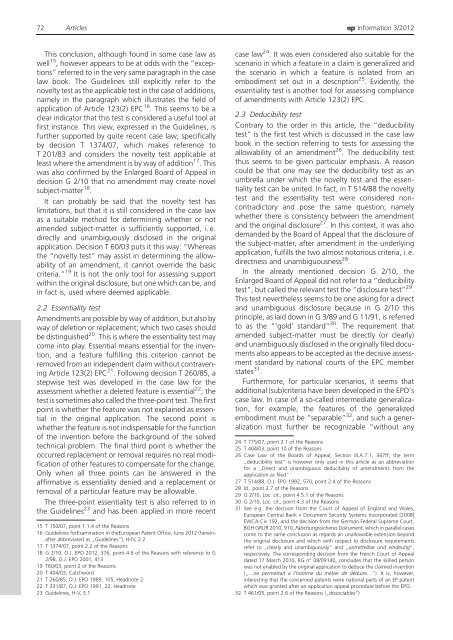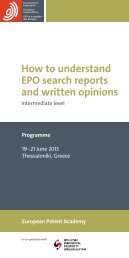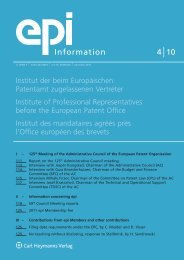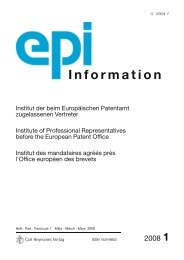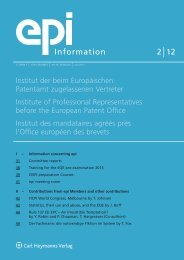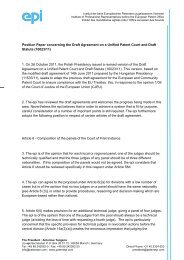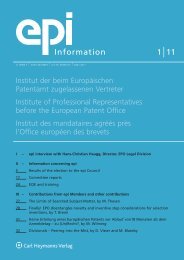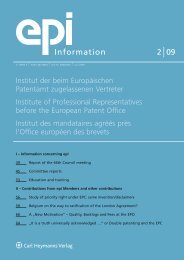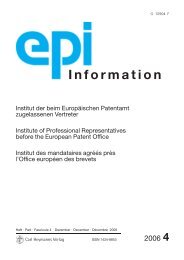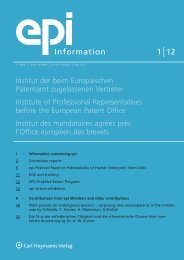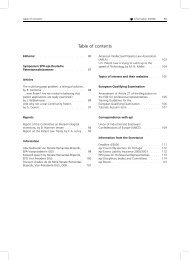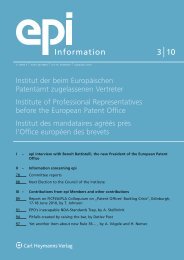You also want an ePaper? Increase the reach of your titles
YUMPU automatically turns print PDFs into web optimized ePapers that Google loves.
72 Articles Information 3/2012<br />
This conclusion, although found in some case law as<br />
well 15 , however appears to be at odds with the “exceptions”<br />
referred to in the very same paragraph in the case<br />
law book. The Guidelines still explicitly refer to the<br />
novelty test as the applicable test in the case of additions,<br />
namely in the paragraph which illustrates the field of<br />
application of Article 123(2) EPC 16 . This seems to be a<br />
clear indicator that this test is considered a useful tool at<br />
first instance. This view, expressed in the Guidelines, is<br />
further supported by quite recent case law; specifically<br />
by decision T 1374/07, which makes reference to<br />
T 201/83 and considers the novelty test applicable at<br />
least where the amendment is by way of addition 17 .This<br />
was also confirmed by the Enlarged Board of Appeal in<br />
decision G 2/10 that no amendment may create novel<br />
subject-matter 18 .<br />
It can probably be said that the novelty test has<br />
limitations, but that it is still considered in the case law<br />
as a suitable method for determining whether or not<br />
amended subject-matter is sufficiently supported, i. e.<br />
directly and unambiguously disclosed in the original<br />
application. Decision T 60/03 puts it this way: “Whereas<br />
the “novelty test” may assist in determining the allowability<br />
of an amendment, it cannot override the basic<br />
criteria.” 19 It is not the only tool for assessing support<br />
within the original disclosure, but one which can be, and<br />
in fact is, used where deemed applicable.<br />
2.2 Essentiality test<br />
Amendments are possible by way of addition, but also by<br />
way of deletion or replacement; which two cases should<br />
be distinguished 20 . This is where the essentiality test may<br />
come into play. Essential means essential for the invention,<br />
and a feature fulfilling this criterion cannot be<br />
removed from an independent claim without contravening<br />
Article 123(2) EPC 21 . Following decision T 260/85, a<br />
stepwise test was developed in the case law for the<br />
assessment whether a deleted feature is essential 22 ; the<br />
test is sometimes also called the three-point test. The first<br />
point is whether the feature was not explained as essential<br />
in the original application. The second point is<br />
whether the feature is not indispensable for the function<br />
of the invention before the background of the solved<br />
technical problem. The final third point is whether the<br />
occurred replacement or removal requires no real modification<br />
of other features to compensate for the change.<br />
Only when all three points can be answered in the<br />
affirmative is essentiality denied and a replacement or<br />
removal of a particular feature may be allowable.<br />
The three-point essentiality test is also referred to in<br />
the Guidelines 23 and has been applied in more recent<br />
15 T 150/07, point 1.1.4 of the Reasons<br />
16 Guidelines forExamination in the<strong>European</strong> <strong>Patent</strong> Office, June 2012 (hereinafter<br />
abbreviated as „Guidelines“), H-IV, 2.2<br />
17 T 1374/07, point 2.2 of the Reasons<br />
18 G 2/10, O.J. EPO 2012, 376, point 4.6 of the Reasons with reference to G<br />
2/98, O.J. EPO 2001, 413<br />
19 T60/03, point 2 of the Reasons<br />
20 T 404/03, Catchword<br />
21 T 260/85, O.J. EPO 1989, 105, Headnote 2<br />
22 T 331/87, O.J. EPO 1991, 22, Headnote<br />
23 Guidelines, H-V, 3.1<br />
case law 24 . It was even considered also suitable for the<br />
scenario in which a feature in a claim is generalized and<br />
the scenario in which a feature is isolated from an<br />
embodiment set out in a description 25 . Evidently, the<br />
essentiality test is another tool for assessing compliance<br />
of amendments with Article 123(2) EPC.<br />
2.3 Deducibility test<br />
Contrary to the order in this article, the “deducibility<br />
test” is the first test which is discussed in the case law<br />
book in the section referring to tests for assessing the<br />
allowability of an amendment 26 . The deducibility test<br />
thus seems to be given particular emphasis. A reason<br />
could be that one may see the deducibility test as an<br />
umbrella under which the novelty test and the essentiality<br />
test can be united. In fact, in T 514/88 the novelty<br />
test and the essentiality test were considered noncontradictory<br />
and pose the same question; namely<br />
whether there is consistency between the amendment<br />
and the original disclosure 27 . In this context, it was also<br />
demanded by the Board of Appeal that the disclosure of<br />
the subject-matter, after amendment in the underlying<br />
application, fulfills the two almost notorious criteria, i. e.<br />
directness and unambiguousness 28 .<br />
In the already mentioned decision G 2/10, the<br />
Enlarged Board of Appeal did not refer to a “deducibility<br />
test”, but called the relevant test the “disclosure test” 29 .<br />
This test nevertheless seems to be one asking for a direct<br />
and unambiguous disclosure because in G 2/10 this<br />
principle, as laid down in G 3/89 and G 11/91, is referred<br />
to as the “‘gold’ standard” 30 . The requirement that<br />
amended subject-matter must be directly (or clearly)<br />
and unambiguously disclosed in the originally filed documents<br />
also appears to be accepted as the decisive assessment<br />
standard by national courts of the EPC member<br />
states 31 .<br />
Furthermore, for particular scenarios, it seems that<br />
additional (sub)criteria have been developed in the EPO’s<br />
case law. In case of a so-called intermediate generalization,<br />
for example, the features of the generalized<br />
embodiment must be “separable” 32 , and such a generalization<br />
must further be recognizable “without any<br />
24 T 775/07, point 2.1 of the Reasons<br />
25 T 404/03, point 10 of the Reasons<br />
26 Case Law of the Boards of Appeal, Section III.A.7.1, 347ff; the term<br />
„deducibility test“ is however only used in this article as an abbreviation<br />
for a „Direct and unambiguous deducibility of amendments from the<br />
application as filed“<br />
27 T 514/88, O.J. EPO 1992, 570, point 2.4 of the Reasons<br />
28 Id., point 2.7 of the Reasons<br />
29 G 2/10, Loc. cit., point 4.5.1 of the Reasons<br />
30 G 2/10, Loc. cit., point 4.3 of the Reasons<br />
31 See e.g. the decision from the Court of Appeal of England and Wales,<br />
<strong>European</strong> Central Bank v Document Security Systems Incorporated [2008]<br />
EWCA Civ 192, and the decision from the German Federal Supreme Court,<br />
BGH GRUR 2010, 910, Fälschungssicheres Dokument, which in parallel cases<br />
come to the same conclusion as regards an unallowable extension beyond<br />
the original disclosure and which with respect to disclosure requirements<br />
refer to „clearly and unambiguously“ and „unmittelbar und eindeutig“,<br />
respectively. The corresponding decision from the French Court of Appeal<br />
dated 17 March 2010, RG n° 08/09140, concludes that the skilled person<br />
was not enabled by the original application to deduce the claimed invention<br />
(„…ne permettait a l’homme du métier de déduire…“). It is, however,<br />
interesting that the concerned patents were national parts of an EP patent<br />
which was granted after an application appeal procedure before the EPO.<br />
32 T 461/05, point 2.6 of the Reasons („dissociables“)


